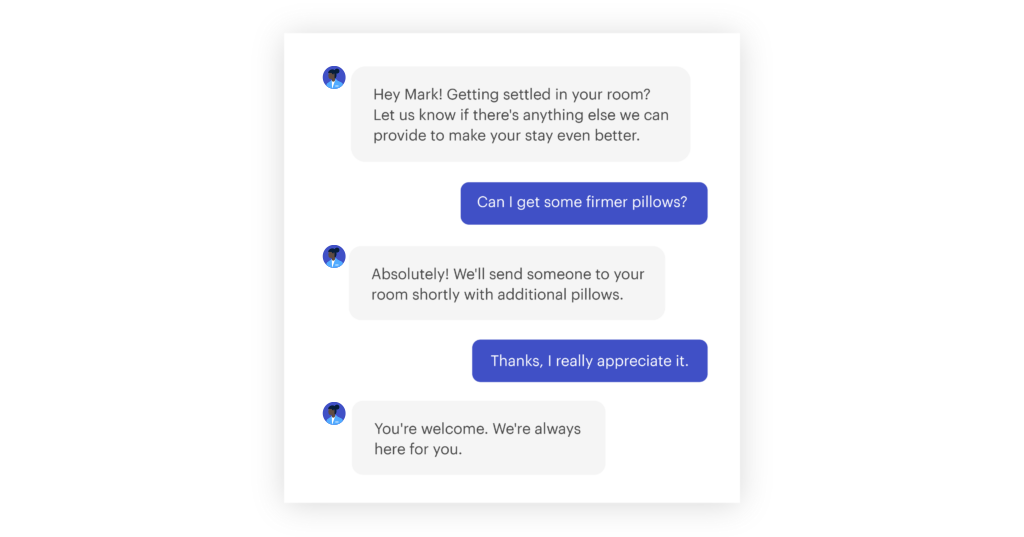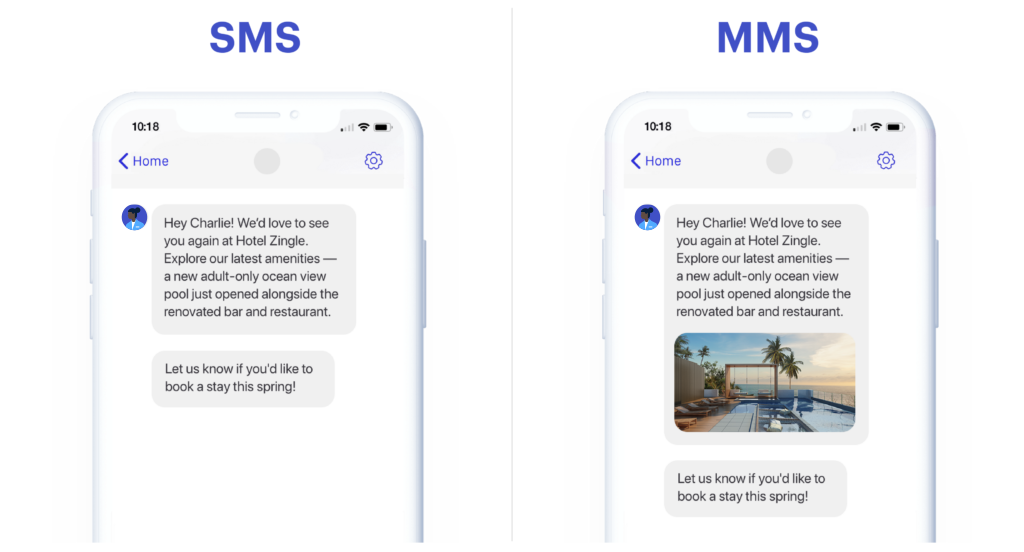SMS vs MMS: What’s the Difference for Business Texting?
November 2, 2021
Customer Experience
Communication with your customers can take place over several channels, but only a business text messaging service provides the perfect mix of two-way, real-time communication with personalization.
What have you used in the past to engage with your customers? If you’ve relied on emails and phone calls, you know how difficult it is to get a response with outreach or keep up with the demand of inbound requests.
The data doesn’t lie, by the way: 48% of consumers prefer direct communication from brands via text messaging, according to SMS Comparison.
Business text messaging takes advantage of the convenience that customers feel while they’re using a mobile device in their everyday lives. Just as they send text messages to a friend or colleague regularly, a business text messaging service allows them to do so with your brand. Not only does this make your business more accessible, but it opens the door to a level of personalization that elevates service and increases satisfaction.
All it takes is just one text to get eyes on your brand, and the ability to engage in a conversation makes it easy to answer questions from prospects or existing customers.
More than 2.2 trillion text messages were sent in the United States in 2020, so it’s unsurprising that several industries are transitioning to business text messaging rapidly. In an effort to reach customers where they spend most of their time, leading companies in healthcare, hospitality, and property management are all adopting a business text messaging service.
Short Message Service (SMS) and Multimedia Messaging Service (MMS) are the global formats used any time you send or receive text messages.
Let’s explain what SMS and MMS are, how they’re different, and what they mean for business text messaging.
Short Message Service: What is SMS?
Pick up your mobile device, and type out a text message without any photos, videos, or files attached to it. Send it to the recipient, then ask yourself: did I think twice about whether or not they received the text message? Chances are you didn’t, and that’s why we’re still using SMS messages to communicate decades after the format arrived on the scene.
SMS made its debut in 1992 in a two-word text message, and it’s more popular than ever nearly 30 years later due to global availability and consistent reliability.
While you can’t say that “everyone texts,” it’s safe to say the vast majority of the global population does. 51% of the global population is using the mobile internet, according to the GSMA, to facilitate text messaging.
When you send or receive an SMS message, it’s a text-only message of up to 160 characters between the sender and the recipient. Any time you write an SMS message exceeding 160 characters, the SMS message is actually split into several SMS messages. Doing this allows wireless networks to transfer the entire text message immediately.
160 characters is the limit for a single SMS message, but major wireless network providers supplying mobile connectivity manage to seamlessly stitch together anything over the ceiling. It’ll appear as a single text message in a conversation thread while technically being more than one SMS message. Rarely, if ever at all, will you see SMS messages divided into segments today.
Wonder why SMS messages are almost always delivered instantly? Since they’re text-only, wireless networks don’t have all that much process to transfer these text messages between people. It ensures the information in a text message gets to the destination in a second or two, not hours later.
Use SMS with a Business Text Messaging Service
SMS messages are quick, which plays right into the fast-paced world of today. No one wants to wait for a response, especially if that means hours or days to hear back. Business text messaging with SMS ensures that you’re in the right place at the right time to communicate with customers.
Rather than only letting feedback come to you, open the lines of communication and start a dialogue with customers first. It’ll lead to brand loyalty that keeps customers coming back to your business.
Here are just a few of the ways in which SMS can be used for business text messaging:
- As a healthcare provider, confirm appointments and inform patients of any health and safety protocols prior to arriving
- As a hotel general manager, notify guests of pre-arrival information (such as check-in times) and send a mid-stay survey to get a pulse on feedback for proactive action
- As a property manager, remind residents when their rent is due — if a lease is close to expiring, highlight any promotions that may encourage a resident to renew
Equip yourself with a business text messaging service to meet the needs of your customers so that your brand earns a reputation for two-way, real-time communication.
Multimedia Messaging Service: What is MMS?
Grab your mobile device once again and type another text message but include an attachment such as a photo or video attached to it. Send it to the recipient and notice that it probably took a little longer to be delivered.
MMS unlocked a new capability for text messaging in the early 2000s: it surpassed the text-only structure of SMS and introduced, as the name suggests, multimedia. Revolutionary in 2002, MMS messages are now a standard part of communication.
As for the 160-character limit imposed by SMS, MMS raises that up to 1,600 characters. It provides the opportunity to get more data, whether from text or multimedia, packed inside a text message. Consider it a way to create dynamic, engaging text messages that bring words to life.
The only catch is that it may take a few extra seconds for an MMS message to be processed, transferred to the recipient, and downloaded for viewing. MMS messages can also compress attachments — particularly with video files — which may reduce quality. Keep that in mind whenever you send or receive an MMS message containing a video that looks somewhat fuzzy.
Use MMS with a Business Text Messaging Service
MMS messages convey exactly who you are as a brand and what you’re talking about, courtesy of the multimedia attached to the text message.
Here are just a few of the ways in which MMS can be used for business text messaging:
- As a healthcare provider, present the signs and symptoms of COVID-19 to advise patients against attending their appointment while infected by the disease
- As a hotel general manager, show off amenities like an infinity pool or premium services like a massage with the option for guests to book by replying
- As a property manager, display a list of all the events taking place on-property or in the neighborhood to drive resident engagement
Each of the activities listed above can be performed with SMS, but MMS adds an extra touch of personality to bring the words to life in the palm of a customer’s hand.
SMS vs MMS: The Difference Between the Texting Formats
Know what the difference between SMS and MMS is yet? If not, don’t worry. We’ll recap for good measure to ensure you understand both texting formats.
SMS is for text-only messages. While you can’t include any attachments, SMS messages are sent and received instantly to ensure a conversation flow as fluid and seamless as your customers expect. It’s ideal for reminders, promotions, and general back-and-forth conversations to get information from a customer or answer any of their questions.
MMS, on the other hand, is for text messages that include a file of nearly any type. Photos, videos, GIFs, PDFs, and other types of attachments can be included with an MMS message. So it adds context to the conversation, whereas an SMS message can’t be brought to life much at all.
Think of MMS messages as SMS messages taken to the next level. With the same reminders and promotions, add a photo to highlight what you’re discussing. MMS messages are especially engaging, and they add a layer of personality to any conversation. Between the two, SMS and MMS are highly effective at not only reaching customers but also engaging them.
Finally, remember this: local, state, and federal governments in your area may have laws for business text messaging that you must comply with.
Business Text Messaging: Use SMS & MMS to Engage with Customers
Two-way, real-time communication with personalization is the future of your marketing efforts. SMS and MMS engage with customers in a way that emails, phone calls, and other forms of communication simply cannot.
Medallia Concierge is an intelligent text and messaging app solution that personalizes and heightens customer and employee experience and builds loyalty. Create opportunities for your brand to engage in a two-way dialogue that makes your customers and employees feel seen, heard, and valued. Uncover deep insights into how people interact with your brand in real time, allowing for swift service recovery and “wow” moments that delight. Let Medallia Concierge empower you to deploy actionable insights that close the loop, increase sales and drive revenue, and drive operational efficiencies throughout your organization.













